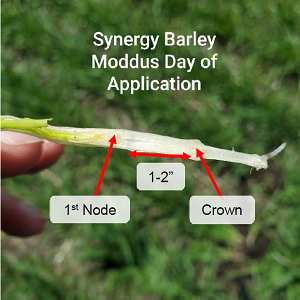
Plant growth regulators (PGRs) on the market today – like Moddus® and Manipulator® – can be valuable tools for decreasing the overall plant height of cereal crops to reduce lodging potential and improve ease of harvest, allowing farmers to strive for maximum yield potential.
Lodged crops are often lower-yielding due to the reduced ability of the plant to take up water and nutrients. Lower crop quality or downgrading can further reduce the return on investment as a result of increased disease in the stem, leaves, and head. Combining crops that are lying flat on the ground decreases the speed of harvest, and makes the process more difficult. Cereal crops treated with PGRs have shorter, stronger stems, resulting in improved standability and less trash for harvesters to process, and this helps to reduce fuel consumption and increase combine speed.
PGRs have the best results on fields with high yield potential. Consider the following criteria: average to above-average in-season rainfall, taller varieties (not semi-dwarf), and high nitrogen fertility programs.
Trials conducted with Moddus® and Manipulator® near Humboldt, SK over the past four years have shown the greatest response on Copeland and Synergy malt barley and durum wheat. Based on these trials, CWRS wheat varieties had little height difference and less yield increase compared to durum or barley.
Staging of PGRs is very important in order to get the maximum benefit from these applications (see this video from Syngenta about crop staging in cereals). While both products advertise a wide application window, the best results are achieved with a single application just prior to stem elongation. The product is meant to take effect on the lowest internodes on the stem, not the leaves. In wheat, barley, and oats, the first registered application window for Manipulator® is at herbicide timing, which occurs between the 2-leaf to the 6-leaf stage for most herbicide products, well before stem elongation. While the timing is convenient for growers, this often means the plant has a wider window to metabolize (neutralize) the product prior to when the stem starts to grow. This results in a lower concentration of the active ingredient in the plant at the time when it can most effectively influence intermodal length. So the shortening effect is reduced. Moddus® cannot be applied at herbicide timing, but rather should be applied at growth stage 31 (shown in the picture below, when stem elongation begins).

A PGR applied at approximately 5-6 leaf when the first node can be felt 1-2 inches above the crown will have maximum shortening effects and yield increase. Later applications just prior to flag leaf have also shown good shortening effect, since the last stem internode under the head will be most affected (shortened). PGRs should not be applied as a tank mix with flag leaf or Fusarium head blight fungicide products, since registered application timing is only up to the early flag leaf stage.
Both Moddus® and Manipulator® have split application rates registered for application twice in one season, however, the single application rate applied at Growth Stage 31-32 has been proven to be the most effective. Both products may be applied up to Growth Stage 37 (flag leaf just visible), except on oats. Manipulator® cannot be applied on oats past Growth Stage 32 to avoid concerns around market access as it relates to maximum residue limits.
Best results have been seen when the grower applies extra nitrogen to take advantage of the increased yield potential when a PGR is applied. Responding to increased yield potential with additional nitrogen from 20-60 lbs per acre above the typical target, along with a balanced nutrient approach has been successful in above-average moisture years. 20 – 60 lbs actual nitrogen over and above the grower’s typical fertilizer rates have been successful for years with good moisture.
Caution is required when applying PGRs in dry seasons. PGRs should not be applied to crops that are drought-stressed, and it’s a good idea to make sure there is significant rainfall in the forecast before applying a PGR to prevent excessive stunting of the crop and reduced yields.
For more information about plant growth regulators, reach out to the experts at your local Richardson Pioneer location.
